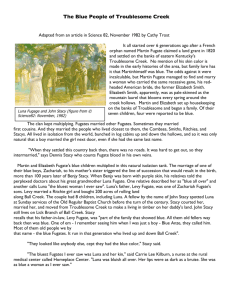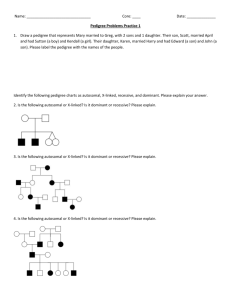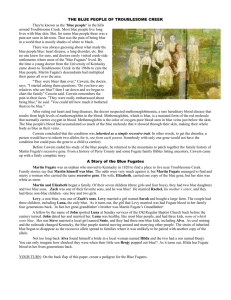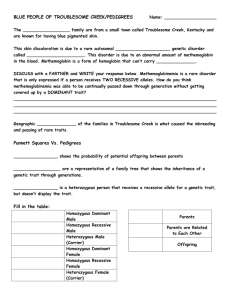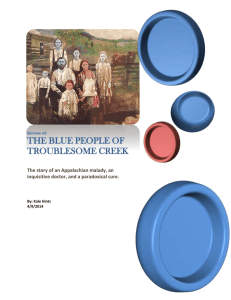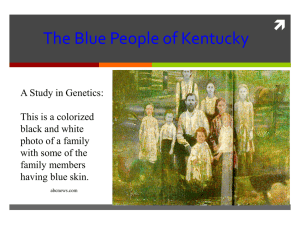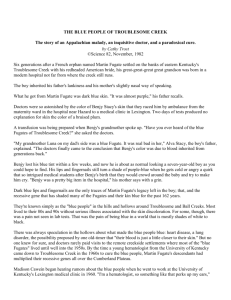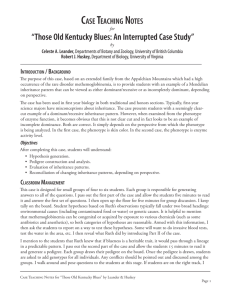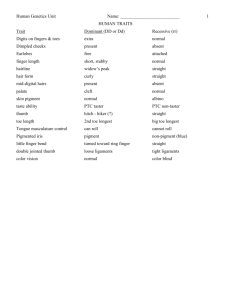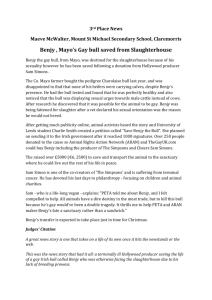The Blue People of Troublesome Creek
advertisement
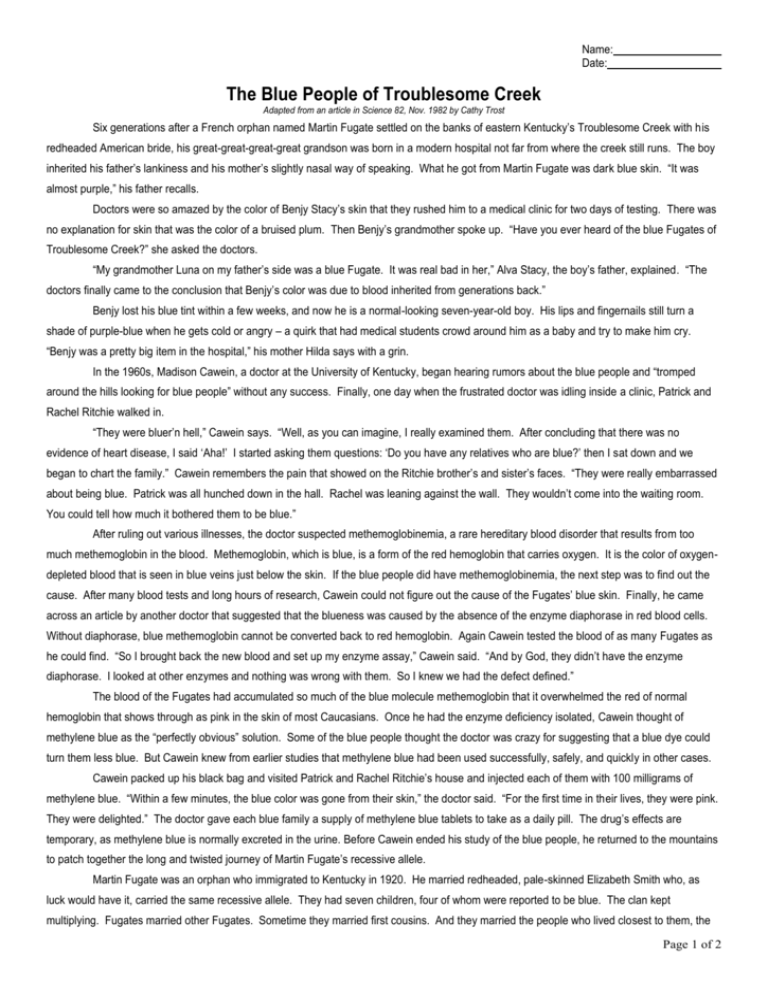
Name: Date: The Blue People of Troublesome Creek Adapted from an article in Science 82, Nov. 1982 by Cathy Trost Six generations after a French orphan named Martin Fugate settled on the banks of eastern Kentucky’s Troublesome Creek with his redheaded American bride, his great-great-great-great grandson was born in a modern hospital not far from where the creek still runs. The boy inherited his father’s lankiness and his mother’s slightly nasal way of speaking. What he got from Martin Fugate was dark blue skin. “It was almost purple,” his father recalls. Doctors were so amazed by the color of Benjy Stacy’s skin that they rushed him to a medical clinic for two days of testing. There was no explanation for skin that was the color of a bruised plum. Then Benjy’s grandmother spoke up. “Have you ever heard of the blue Fugates of Troublesome Creek?” she asked the doctors. “My grandmother Luna on my father’s side was a blue Fugate. It was real bad in her,” Alva Stacy, the boy’s father, explained. “The doctors finally came to the conclusion that Benjy’s color was due to blood inherited from generations back.” Benjy lost his blue tint within a few weeks, and now he is a normal-looking seven-year-old boy. His lips and fingernails still turn a shade of purple-blue when he gets cold or angry – a quirk that had medical students crowd around him as a baby and try to make him cry. “Benjy was a pretty big item in the hospital,” his mother Hilda says with a grin. In the 1960s, Madison Cawein, a doctor at the University of Kentucky, began hearing rumors about the blue people and “tromped around the hills looking for blue people” without any success. Finally, one day when the frustrated doctor was idling inside a clinic, Patrick and Rachel Ritchie walked in. “They were bluer’n hell,” Cawein says. “Well, as you can imagine, I really examined them. After concluding that there was no evidence of heart disease, I said ‘Aha!’ I started asking them questions: ‘Do you have any relatives who are blue?’ then I sat down and we began to chart the family.” Cawein remembers the pain that showed on the Ritchie brother’s and sister’s faces. “They were really embarrassed about being blue. Patrick was all hunched down in the hall. Rachel was leaning against the wall. They wouldn’t come into the waiting room. You could tell how much it bothered them to be blue.” After ruling out various illnesses, the doctor suspected methemoglobinemia, a rare hereditary blood disorder that results from too much methemoglobin in the blood. Methemoglobin, which is blue, is a form of the red hemoglobin that carries oxygen. It is the color of oxygendepleted blood that is seen in blue veins just below the skin. If the blue people did have methemoglobinemia, the next step was to find out the cause. After many blood tests and long hours of research, Cawein could not figure out the cause of the Fugates’ blue skin. Finally, he came across an article by another doctor that suggested that the blueness was caused by the absence of the enzyme diaphorase in red blood cells. Without diaphorase, blue methemoglobin cannot be converted back to red hemoglobin. Again Cawein tested the blood of as many Fugates as he could find. “So I brought back the new blood and set up my enzyme assay,” Cawein said. “And by God, they didn’t have the enzyme diaphorase. I looked at other enzymes and nothing was wrong with them. So I knew we had the defect defined.” The blood of the Fugates had accumulated so much of the blue molecule methemoglobin that it overwhelmed the red of normal hemoglobin that shows through as pink in the skin of most Caucasians. Once he had the enzyme deficiency isolated, Cawein thought of methylene blue as the “perfectly obvious” solution. Some of the blue people thought the doctor was crazy for suggesting that a blue dye could turn them less blue. But Cawein knew from earlier studies that methylene blue had been used successfully, safely, and quickly in other cases. Cawein packed up his black bag and visited Patrick and Rachel Ritchie’s house and injected each of them with 100 milligrams of methylene blue. “Within a few minutes, the blue color was gone from their skin,” the doctor said. “For the first time in their lives, they were pink. They were delighted.” The doctor gave each blue family a supply of methylene blue tablets to take as a daily pill. The drug’s effects are temporary, as methylene blue is normally excreted in the urine. Before Cawein ended his study of the blue people, he returned to the mountains to patch together the long and twisted journey of Martin Fugate’s recessive allele. Martin Fugate was an orphan who immigrated to Kentucky in 1920. He married redheaded, pale-skinned Elizabeth Smith who, as luck would have it, carried the same recessive allele. They had seven children, four of whom were reported to be blue. The clan kept multiplying. Fugates married other Fugates. Sometime they married first cousins. And they married the people who lived closest to them, the Page 1 of 2 Combses, Smiths, Ritchies, and Stacys. All lived in isolation from the world, bunched up in cabins up and down the hollows, and so it was only natural that a boy married the girl next door, even if she had the same last name. One of Elizabeth and Martin’s blue boys, Zachariah, married Elizabeth’s sister and had children. One of the boys, Levy Fugate, married Mahala Ritchie. They had eight children, including one girl named Luna. Luna was Benjy Stacy’s great grandmother. A nurse who works at the rural medical center nearby remembers, “The bluest Fugates I ever saw was Luna and her kin. Luna was bluish all over. Her lips were as dark as a bruise. She was as blue a woman as I ever saw.” Luna Fugate married John Stacy, who still lives near Troublesome Creek. They had 13 children, none of whom were blue. As coal mining and the railroads brought progress to Kentucky, the blue Fugates started moving out of their communities and marrying other people. The strain of inherited blue began to disappear as the recessive gene spread to families where it was unlikely to be paired with a similar gene. Benjy Stacy is one of the last of the blue Fugates. With Fugate blood on both his mother’s and his father’s side, the boy could have received genes for the enzyme deficiency from either direction. Because the boy was intensely blue at birth but then recovered his normal skin tones, Benjy is assume to have inherited only one allele for the condition. Such people tend to be blue only at birth, probably because newborns normally have smaller amounts of diaphorase. The enzyme eventually builds to normal levels in most children and to almost normal levels in those like Benjy, who carry one recessive allele. Cawein and his colleagues published their research on hereditary diaphorase deficiency in 1964. He hasn’t studied the condition in years. The producers of the television show “That’s Incredible” recently approached him. They wanted to parade the blue people across the screen in their weekly display of human oddities. Cawein would have no part of it, and he related with glee that a film crew sent to Kentucky from Hollywood fled the “two mean dogs in every front yard” without any film. He cheers their bad luck, not out of malice, but out of a deep respect for the blue people of Troublesome Creek. Now that you have read the story, “The Blue People of Troublesome Creek,” complete the pedigree below. The Fugate Pedigree: (with phenotypes only) Martin Fugate This modified pedigree is only an approximation. Elizabeth Smith Complete the pedigree by: - shading the symbols that need to be shaded - writing the genotype of each person next to his/her name. Use the letter B to represent the allele for the gene that codes for the enzyme diaphorase. 7 children, 4 blue Zachariah Fugate (unknown name) Levi Fugate Mahala Ritchie 8 children, 1 blue Luna Fugate John Stacy 13 children, none blue Unknown Unknown Alva Stacy Hilda Godsey Remember that seemingly unaffected individuals might be carriers of the allele. If you are not sure that a person is a carrier, leave the genotype as B__. Do not just randomly guess at the genotype. Recommendation: USE A PENCIL. Benjy Stacy Page 2 of 2

